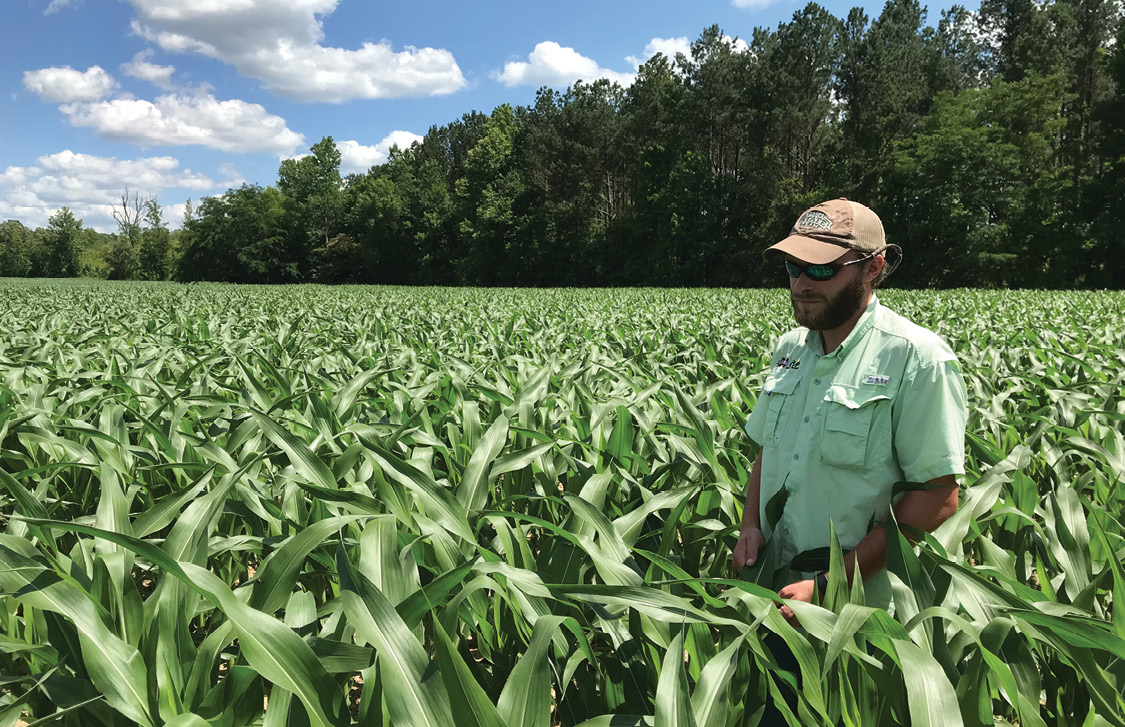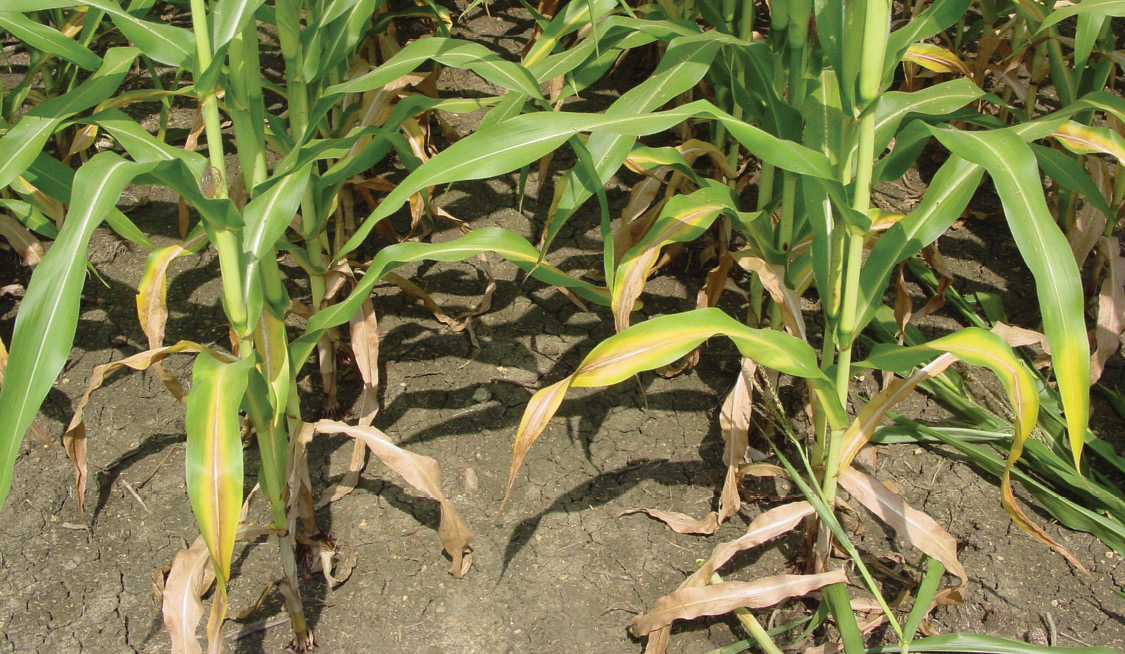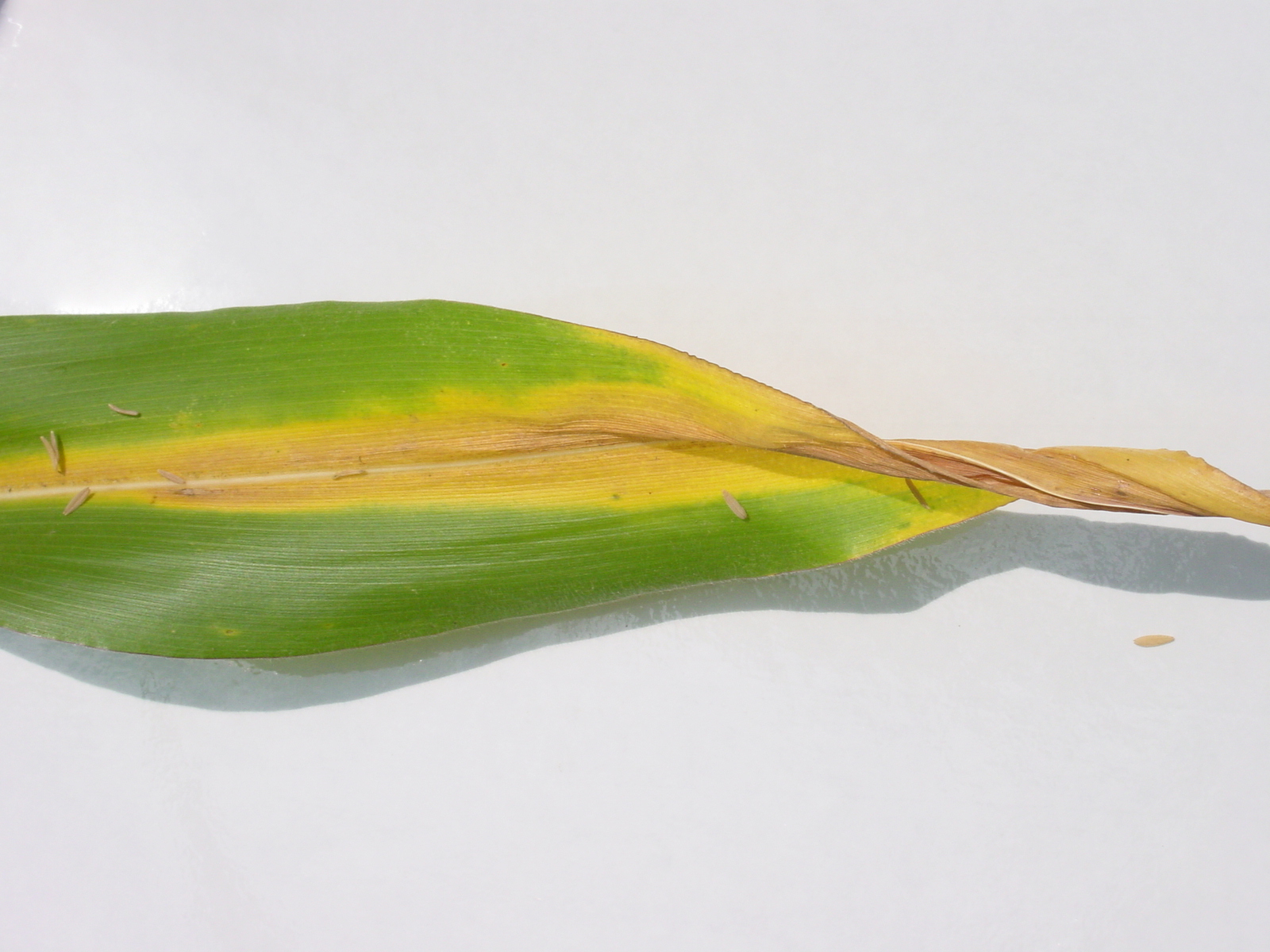Corn Fertilization
Adequate soil fertility is a must for good corn production. Fertility requirements depend on yield goals, soil fertility levels, and cropping systems. Balanced fertility management is necessary to produce corn for more profit. Corn yields are often limited by low soil pH and nutrient deficiencies or toxicities. Severe soil fertility problems may also promote other stresses because they reduce plant health.

Soil Testing
Soil testing is a best management practice and should be the foundation for corn fertility decisions. Soil testing eliminates guesswork, allowing you to address any nutrient problems. You should test soil at least every three years, using good sampling techniques and the right equipment. Mississippi corn is usually grown in yearly rotation with other crops. More frequent or even yearly soil testing may be helpful because crop nutrient demands often differ greatly. More information on soil sampling for agronomic crop production is available in MSU Extension Service P3858 Soil Testing for the Farmer.
Soil pH
Low pH, or acidic, soils are common in most of Mississippi because high rainfall (40 to 55 inches per year) and warm temperatures speed the weathering of soil and remove basic cations. Soils can be made more acidic by applying fertilizer.
The ideal soil pH for corn production is from 6.0 to 7.0. When soil pH is less than 5.5, corn plants begin to develop problems. Soil pH can affect nutrient availability. Aluminum and manganese become more available in acid soils and may reach levels that stunt or kill plants. Low pH soil also makes phosphorus, nitrogen, potassium, sulfur, magnesium, and calcium less available to growing plants. Acidic soil can limit root growth and the activity of some helpful soil microorganisms.

You can add lime to the soil to address acidity problems. Lime is best applied in the fall so soil acidity is neutralized before crop growth begins. But if you can’t apply lime in fall, applying it in spring is still better than not applying it at all.
Lime recommendations for agronomic crops are included in routine soil test analyses. The lime recommendation is based on the buffer capacity of the particular soil. Buffer capacity is the soil’s natural ability to resist a change in pH. It is influenced by the soil’s capacity to exchange cations, which depends on the organic matter and clay minerals in the soil. Often soils with similar pH have different lime recommendations because their buffer capacity differs.
Several types of lime are available in Mississippi, including calcitic, marls, and dolomitic. Marls are soft deposits of calcium carbonate and are usually very moist. Calcitic lime is very hard calcium carbonate. Dolomitic limestones contain both magnesium and calcium carbonates. Marls are quarried within Mississippi, but most calcitic and dolomitic limestones aren’t. The cost of transporting lime makes it expensive, so use good quality lime. Lime quality depends on how pure and fine it is. The law requires vendors of agricultural liming materials to submit samples for state testing of these two properties. Vendors must provide these results upon request. For more information on lime quality, see MSU Extension Service P3762 Agricultural Limestone’s Neutralizing Value.
Nitrogen
It’s important to manage nitrogen (N) for both financial and environmental reasons. Corn can use more nitrogen than soil or air can supply. Nitrogen management in crop production is a concern for some because of possible movement to ground and surface waters.
Corn plants with a nitrogen deficiency at first take on a pale, yellowish-green look. Leaves often develop yellowing in an inverted-V pattern beginning on the tips of lower or older leaves. If the deficiency worsens, leaf tissue may “fire” or die in the same pattern described above.

MSU Extension generally recommends using 1.3 pounds of actual nitrogen for each bushel of corn yield goal. For example, the nitrogen recommendation for a goal of 200 bushels per acre is
(1.3 lb N × 200 bu/A) = 260 lb N/A
But research shows you can use 10 to 15 percent less nitrogen than the standard recommendation if you are growing corn on lighter, sandier soil. Nitrogen recommendations for corn in the South are based totally on corn yield goal because our warm, wet winters keep nitrogen from carrying over from year to year. This is different from the Midwest, where consistently cold, dry conditions effectively stop nitrogen loss during the winter.
Because Mississippi springs are often very wet, we suggest you apply nitrogen fertilizer at different times according to crop need. This split application method reduces the likelihood of considerable nitrogen loss due to wet weather before the crop can use it. Corn uses less than 10 percent of its nitrogen before rapid vegetative growth begins. This growth spurt usually happens in late April through mid-May, depending on planting date and seasonal temperatures. You can use nitrogen more efficiently if you apply only a small portion just after plants emerge. Add the bulk of your nitrogen fertilizer just before the growth spurt, when the plants need it most. Our standard nitrogen recommendation is to apply no more than one-third of the total nitrogen near planting/crop emergence. Apply the remaining nitrogen about 30 days later. Corn should be higher than 12 inches or at V6 growth stage by the second application. Top-dressing urea is becoming more popular and can improve nitrogen efficiency, particularly if you add a pre-tassel application, if it is incorporated through rainfall or irrigation.

Early fertilization can waste a lot of nitrogen, especially if there’s a long period of wet weather before rapid corn growth begins. Nitrogen loss because of saturated soil happens mostly through denitrification, particularly in heavy, clay soils. Denitrification happens when microorganisms turn nitrate nitrogen into nitrogen gas. These gases then escape into the air. Warm soil temperatures speed up this process. Research indicates denitrification rates range from 2 to 3 percent per day at soil temperatures from 55 to 65˚F. Denitrification rates increase to about 5 percent per day when soil temperatures are warmer.
Nitrate moves easily in moist fields. All forms of nitrogen can change fairly quickly compared to other nutrients. In warm, humid climates such as in Mississippi, soil-based nitrogen changes happen throughout the year. You should decide which nitrogen to buy based on price, availability, ease of application, and potential for volatilization. All sources of nitrogen are equally good if you apply them properly in the right situations.
Using the right nitrogen source and application method may be more important to corn grain yield than how much you apply. No-tillage research studies in Missouri and Tennessee show UAN-solution (N-sol) and urea broadcast on the soil surface reduced corn yield potential 9 to 23 percent compared to ammonium nitrate broadcast, N-sol injected, or anhydrous ammonia injected. Urea-containing nitrogen sources, including UAN-solution (N-sol, 32% or 28-0-0-5) and urea (46-0-0 or 41-0-0-5), may not work as well because they are subject to volatilization loss when applied to the soil surface (either broadcast or dribbled in a band). Surface-applied urea sources readily volatilize when there’s a lot of vegetation or crop residue on the ground, when temperatures are higher than 55˚F, and when rates exceed 100 pounds of nitrogen per acre, until rainfall incorporates the nitrogen. You’re likely to lose a lot of nitrogen to volatility if you broadcast urea nitrogen sources just before a long dry period.
Urease inhibitors containing the active ingredient NBPT can limit volatility of top-dressed urea or dribbled N-sol. Urease inhibitors temporarily slow the activity of the urease enzyme. But you’ll still need timely rainfall or overhead irrigation to get urea-based nitrogen into the soil so the plants can use it. Thus, surface application of N-sol or urea may present considerable risk, particularly for dryland corn production systems, when it comprises a majority of your nitrogen fertility program.
Phosphorus and Potassium
Apply phosphate and potash fertilizers according to soil test results. The MSU Extension Service soil test gives the pounds per acre measured by the analysis and an index value: very low, low, medium, high, or very high. Soil tests with high and very high indices usually won’t respond to additional fertilizer, so fertilizer is not recommended. If your soil tests medium or below, the results will include fertilizer recommendations.
Phosphorus nutrition is important to crop maturity, root and stalk development, and energy transfer and storage. Young corn plants often turn purple if they have a phosphorus deficiency. The coloring shows up first on lower leaf tips and moves along leaf margins until the entire leaf looks purple. New leaves emerging from the whorl usually start out green but may turn purple quickly.

Young plants often develop phosphorus deficiency symptoms when they are exposed to warm, sunny growing conditions just after cool, wet conditions. This weather pattern causes the vegetation to grow faster than the roots can keep up. As a result, the plants can’t get enough phosphorus to support growth. This is especially a problem for young plants because their root systems are small and phosphorus doesn’t move much in the soil. Plants normally recover when good growing conditions promote root expansion and allow more nutrient uptake.
Phosphorus deficiency is very common when you grow corn after rice. The absence of a flood changes ferrous phosphates, which plants can use, to ferric phosphates, which plants cannot use. It’s also common when corn is grown in rotation with cotton or soybeans, because corn uses nearly twice as much phosphorus as cotton and soybeans.
Corn hybrids often differ widely in how purple they turn—so don’t be alarmed if the color on one hybrid is brighter than on others. Hybrids differ in the production of pigments responsible for the purple color.
The purple color usually disappears before plants get 2 to 3 feet tall, even when soil phosphorus levels are low. Phosphorus deficiency may still reduce yield by delaying maturity, decreasing root growth, and reducing energy transfer and storage.
Many cultural or environmental factors can limit root growth, making a phosphorus deficiency worse. These are examples:
- cool temperatures
- too wet or dry soil
- low soil pH
- compacted soil
- herbicide damage
- insect damage
- root pruning by side-dressing knives or cultivators
Soil pH may also contribute to phosphorus deficiency. Low soil pH can severely limit plants from absorbing phosphorus, causing deficiency symptoms even where there’s a lot of phosphorus in the soil. Soil pH less than 5.5 may reduce the availability of phosphorus in the soil solution by more than 30 percent. Acidic soil also reduces root growth, which is necessary for phosphorus uptake.
Treating a phosphorus deficiency takes time because phosphorus is immobile in the soil. Plant roots must grow into the zone where you applied fertilizer before they can absorb the phosphorus for the plant to use. If you apply phosphorus fertilizer to the surface of the ground, it will be available only in the top couple of inches of soil. For this reason, broadcast phosphorus only on irrigated and/or minimum tillage fields with substantial crop residue on the soil surface. These factors promote soil moisture, root activity, and nutrient uptake in the upper few inches of soil. In most situations, especially in dryland fields, you’ll want to inject phosphorus as a side-dress treatment. But be very careful not to harm roots when side-dressing.
You should generally apply phosphorus in the fall for an upcoming crop. That way, tillage will help incorporate the fertilizer into the soil. Stale seedbed systems and wet spring soils often make spring application impractical. Fall tillage helps incorporate the fertilizer into the soil, increasing nutrient availability to roots and reducing potential for runoff loss. Fertilizer injection may accomplish the same goals.
Many corn growers use starter fertilizer to supplement their corn fertility program and improve phosphorus availability. Starter fertilizer promotes earlier maturity, enhances plant vigor, and often improves grain yield, especially in minimum or no-tillage systems. Starter fertilizer works mostly by providing a concentrated phosphorus supply in the root zone of young plants. Phosphorus placement is very important to young plants with small root systems because phosphorus doesn’t move in the soil. But even though nitrogen is an important part of starter fertilizer, it can move in the soil. That’s why nitrogen placement is not as important to corn uptake, especially since corn has a fibrous root system with lots of lateral growth. Thus, nitrogen fertilizers alone are not very valuable as starter fertilizers.
The most commonly used source of starter fertilizer is ammonium polyphosphate (10-34-0 or 11-37-0). Many brands of orthophosphate fertilizers are readily available. But they are much more expensive, have lower nutrient analyses, and routinely show no yield difference compared to polyphosphate fertilizers in field trials.
When you apply starter fertilizer in the seed furrow, use no more than 4 gallons of ammonium polyphosphate per acre in 38- to 40-inch rows or 5 gallons per acre in 30-inch rows. Otherwise, you may cause salting injury to seedlings. Corn Belt growers often use coulter rigs that band starter fertilizer to the side and below the seed. These systems are efficient, safe for the plant, and effective.
Corn requires as much potassium as it does nitrogen. Potassium is necessary to build strong stalks, fight diseases, and move water within the plant. The main symptom of potassium deficiency is chlorosis (yellowing) followed by necrosis (tissue death) along lower leaf margins, beginning at the leaf tip.

A lot of the potassium crops take up is recycled to the soil through crop residue. However, if vegetation is removed from the field, such as with a forage crop or silage harvest, potassium recommendations will be much higher. A good corn silage crop removes more than 200 pounds of potassium per acre. Soybeans remove more potassium from the soil, relative to other Mississippi row crops, because more potassium is allocated to the seed—about 1.4 pounds of potassium per bushel of grain harvested. Potassium deficiency is common in corn grown in rotation with soybeans.
Potassium deficiency may be more likely in no-till systems, where the combine spreader affects crop residue distribution. If residue is “windrowed” behind the combine, the edges of the pattern have less potassium. Those areas are more likely to develop deficiency in the next crop.
You can apply potassium fertilizer in the fall because, like phosphorus, potassium is relatively immobile in most soils. But potassium leaches on sandy soils with cation exchange capacity (CEC) less than 8.0. Spring or in-season application is recommended on these soils.
Sulfur, Magnesium, and Zinc
High-yielding corn crops can take up more than 35 pounds of sulfur and magnesium. Sulfur and magnesium deficiencies are most likely on sandy soils with less than 1 percent organic matter, especially during cool, wet conditions. Furthermore, sulfur deficiency has become more common as atmospheric deposition has decreased over the past three decades. Sulfur and magnesium deficiencies cause yellowish-white interveinal striping or general yellowing of the foliage. Sulfur symptoms appear first and are more pronounced on upper or younger leaves, whereas magnesium symptoms appear on lower or older leaves.

If you diagnose a sulfur deficiency on a growing crop, apply a sulfate form of sulfur as quickly as possible. Sources of sulfate sulfur include mixed homogeneous fertilizers with sulfur added, ammonium sulfate, gypsum, K-Mag, and ammonium thiosulfate (12-0-0-26 liquid). You can apply elemental sulfur as preventive maintenance, but it takes several months to change into the sulfate form the plant can use. The two main sources of magnesium are K-Mag and dolomitic limestone (if lime is recommended).
Zinc deficiencies are most common on sandy, low organic matter soils, especially during cool, wet conditions. High pH and phosphorus levels increase the chances of deficiency. Zinc deficiency symptoms are usually evident several weeks after emergence as light interveinal striping or a whitish band beginning at the leaf base of young leaves. Follow soil test and plant analyses to avoid zinc deficiencies.

The information given here is for educational purposes only. References to commercial products, trade names, or suppliers are made with the understanding that no endorsement is implied and that no discrimination against other products or suppliers is intended.
Publication 3591 (POD-05-24)
By Erick Larson, PhD, Extension/Research Professor, and Larry Oldham, PhD, Extension Professor (retired), Plant and Soil Sciences.
The Mississippi State University Extension Service is working to ensure all web content is accessible to all users. If you need assistance accessing any of our content, please email the webteam or call 662-325-2262.


